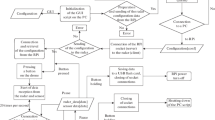Abstract
Under support from the Army Research Laboratory’s Partnerships in Research Transition program, a stepped-frequency radar (SFR) is currently under development, which allows for manipulation of the radiated spectrum while still maintaining an effective ultra-wide bandwidth. The SFR is a vehicle-mounted forward-looking ground-penetrating radar designed for high-resolution detection of buried landmines and improvised explosive devices. The SFR can be configured to precisely excise prohibited or interfering frequency bands and also possesses frequency-hopping capabilities. This paper discusses the expected performance features of the SFR as derived from laboratory testing and characterization. Ghosts and artifacts appearing in the range profile arise from gaps in the operating band when the system is configured to omit specific frequencies. An analysis of these effects is discussed and our current solution is presented. Future prospects for the SFR are also discussed, including data collection campaigns at the Army’s Adelphi Laboratory Center and the Countermine Test Site.







Similar content being viewed by others
Notes
The Tx/Rx switch controls can be changed with 12.5 ns resolution, allowing for various systems pulse widths and minimum ranges to be analyzed.
References
Koenig, F., Ressler, M., Smith, G., Nguyen, L., & Harris, R. (2008). Synchronous impulse reconstruction (SIRE) radar sensor. Technical report ARL-TR- 4661, The Army Research Laboratory.
Ressler, M., Nguyen, L., Koenig, F., Wong, D., & Smith, G. (2007). The Army Research Laboratory (ARL) Synchronous impulse reconstruction (SIRE) forward-looking radar. In Proceedings of the SPIE Conference on Unmanned Systems Technology IX (Vol. 6561, pp. 656105–1–656105–12). Orlando, FL.
Phelan, B. R., Ressler, M. A., Mazzaro, G. J., Sherbondy, K. D., & Narayanan, R. M. (2013). Design of spectrally versatile forward-looking ground penetrating radar for detection of concealed targets. In Proceedings of the SPIE Conference on Radar Sensor Technology XVII (Vol. 8714, pp. 87140B–1–87140B–10). Baltimore, MD.
Narayanan, R. M. (2003). Radar imaging using spectrally fragmented ultra-wideband (UWB) noise waveforms. In Proceedings of the 14th AFOSR Electromagnetics Workshop (pp. P4–P5). San Antonio, TX.
Daniels, D. (2010). EM detection of concealed targets (pp. 170–177). Hoboken, NJ: Wiley.
Gill, G. (2000). High-resolution step-frequency radar. In J. D. Taylor (Ed.), Ultra-wideband radar technology (pp. 303–325). Boca Raton, FL: CRC.
Bradley, M., Witten, T., McCummins, R., & Duncan, M. (2002). Mine detection with ground penetrating synthetic aperture radar. In Proceedings of the SPIE Conference on Detection and Remediation Technologies for Mines and Minelike Targets VII (Vol. 4742, pp. 248–258). Orlando, FL.
Bradley, M., Witten, T., Duncan, M., & McCummins, B. (2003). Mine detection with a forward-looking ground-penetrating synthetic aperture radar. In Proceedings of the SPIE Conference on Detection and Remediation Technologies for Mines and Minelike Targets VII (Vol. 5089, pp. 334–347). Orlando, FL.
Bradley, M., Witten, T., Duncan, M., & McCummins, B. (2004) Anti-tank and side-attack mine detection with a forward-looking GPR. In Proceedings of the SPIE Conference on Detection and Remediation Technologies for Mines and Minelike Targets VII (Vol. 5415, pp. 421–432). Orlando, FL.
Hunt, A., & Hogg, R. (2002). A stepped-frequency, CW radar for concealed weapon detection and through the wall surveillance. In Proceedings of the SPIE Conference on Sensors, and Command, Control, Communications, and Intelligence Technologies for Homeland Defense and Law Enforcement (Vol. 4708, pp. 99–105). Orlando, FL.
Hunt, A. (2009). Use of a frequency-hopping radar for imaging and motion detection through walls. IEEE Transactions on Geoscience and Remote Sensing, 47(5), 1402–1408.
Kositsky, J. (2000). Results from a forward-looking GPR mine detection system. In Proceedings of the SPIE Conference on Detection and Remediation Technologies for Mines and Minelike Targets V (Vol. 4038, pp. 1077–1087). Orlando, FL.
Kositsky, J., & Amazeen, C. (2001). Results from a forward-looking GPR mine detection system. In Proceedings of the SPIE Conference on Detection and Remediation Technologies for Mines and Minelike Targets V (Vol. 4394, pp. 700–711). Orlando, FL.
National Telecommunications and Information Administration. (2013). Manual of regulations and procedures for Federal Radio Frequency Management. Washington, DC: U.S. Department of Commerce.
Nguyen, L. H., & Tran, T. D. (2012). Robust and adaptive extraction of RFI signals from ultra-wideband radar data. In Proceedings of the 2012 IEEE International Geoscience and Remote Sensing Symposium (IGARSS) (pp. 7137–7140). Munich, Germany.
Ranney, K., Nguyen, L., & Sichina, J. (2010). Iterative sidelobe reduction in transmission-constrained, stepped frequency, synthetic aperture radar. In Proceedings of the SPIE Conference on Radar Sensor Technology XIV (Vol. 7669, pp. 766919–1–766919–6). Orlando, FL.
Nguyen, L., & Soumekh, M. (2005). Improving SAR image of mine-type targets from restricted radar band data. In Proceedings of the SPIE Conference on Detection and Remediation Technologies for Mines and Minelike Targets X (Vol. 5794, pp. 522–531). Orlando, FL.
Nguyen, L., Wong, D., Ressler, M., Koenig, F., Stanton, B., Smith, G., et al. (2007). Obstacle avoidance and concealed target detection using the Army Research Lab ultra-wideband synchronous impulse reconstruction (UWB SIRE) forward imaging radar. In Proceedings of the SPIE Conference on Detection and Remediation Technologies for Mines and Minelike Targets XII (Vol. 6553, pp. 65530H–1–65530H–8). Orlando, FL.
Acknowledgments
This work was supported by the US Army Research Office Grant W911NF-12-1-0305 through Delaware State University.
Author information
Authors and Affiliations
Corresponding author
Additional information
This article is part of the Topical Collection on Forward-Looking Ground-Penetrating Radar.
Rights and permissions
About this article
Cite this article
Phelan, B.R., Gallagher, K.A., Sherbondy, K.D. et al. Development and Performance of an Ultrawideband Stepped-Frequency Radar for Landmine and Improvised Explosive Device (IED) Detection. Sens Imaging 15, 90 (2014). https://doi.org/10.1007/s11220-014-0090-z
Received:
Revised:
Published:
DOI: https://doi.org/10.1007/s11220-014-0090-z




